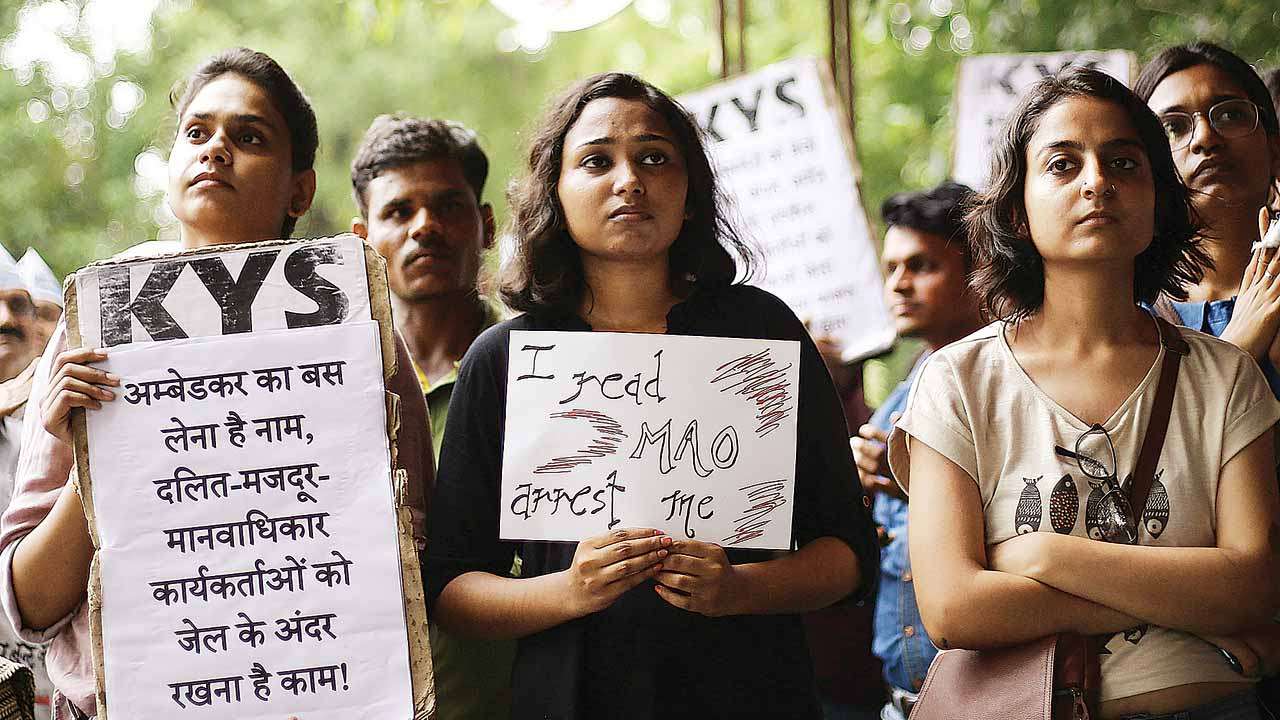
On Wednesday, August 28, Maharashtra police arrested four “Maoist sympathisers” and political activists: Varavara Rao, Vernon Gonsalves, Arun Ferreira, Sudha Bharadwaj, and Gautam Navlakha. In addition, they launched simultaneous raids on the premises of Father Stan Swamy, Susan Abraham, and Anand Teltumbde. A social media storm has predictably broken out over these arrests and raids, with supporters and opponents at loggerheads, clearly divided and demarcated. In the process, most of us have forgotten what the key issue is.
Indeed, that is one reason I have avoided using the buzzword, or should I say catchphrase, over which the current conflict is being waged — Urban Naxal. This term has entered our common lexicon thanks to a book by my friend, filmmaker Vivek Agnihotri. As it happens, I have written the Foreword, something that I rarely do, to that book. A catchphrase may represent the climax of a plot or an important term in a narrative war. Urban Naxal is one such phrase. What it forces us to acknowledge is the fact that Naxalism, or more properly, Maoist insurgency, is not confined to far-off places, impenetrable forests, and “backward” interiors of the country, but needs a strong urban base, backed by intellectual, media, and legal support. Vivek’s campaign helps us focus on this often-hidden nexus. In that sense, the debate over Urban Naxals is not only timely, but long overdue.
At the same time, as is often the case, buzzwords and catchphrases may also divert or detract from the real issue. In this case, many who are crossing ideological swords and jousting over Urban Naxals have forgotten that Tuesday’s raids and custodial detentions are part of a crackdown that started earlier this year, on June 6, with the arrests of Surendra Gadling, Shoma Sen, Sudhir Dhawale, Mahesh Raut, and Rona Wilson. How and why did the investigative agencies target these people, some of whom have been known as social activists, human rights advocates, teachers, and writers?
Actually, an FIR was filed on January 8, 2018 against the Kabir Kala Manch (KKM) by Tushar Ramesh Damgude. Damgude went to a meeting of the Elgar Parishad on December 31, 2017, where he heard allegedly provocative and objectionable statements. The meeting commemorated the Battle of Koregaon on January 1, 1818, between the Maratha Confederacy, led by the Peshwas, and the British. Actually, the battle itself was somewhat indecisive. Elphinstone, who visited the site shortly thereafter, called it a small victory for the Peshwa. But this skirmish was one of the last in the Third Anglo-Maratha War, which the British won. No wonder, they erected a victory obelisk to commemorate it.
The renewed battle, now rechristened “Bhima Koregaon”, started long after. Bhima is not only the name of the river that flows nearby or the village in the vicinity, but Dr Ambedkar’s first name too. It thus became the rallying cry of neo-Ambedkarites. Dr. Ambedkar visited the site on January 1, 1927. Some 50 of the memorialised British troops on the obelisk have identifiable Mahar last names. The obelisk therefore became a symbol of Dalit martial prowess and victory over “Brahmanical oppression”. Of course, the Mahars fought for the Peshwas too, a fact conveniently overlooked by those making caste capital out of the battle of Koregaon.
On January 1 2018, a day after the Elgar Parishad meeting which Damgude attended, violent clashes and rioting broke out during the Koregaon Bhima celebration. Property worth hundreds of crores was destroyed, scores of people including police personnel, sustained injuries, and one youth lost his life. Several observers felt that there was a conspiracy behind the protests. Their aim was to create, if not a caste war, at least severe caste disaffection, which could be turned against the BJP, the ruling party both at the Centre and in the state of Maharashtra.
The KMM had been under the scanner even during the UPA regime. Damgude, who filed the FIR on January 8, 2018, was quoted as saying, “I had gone there to listen…various speakers in Elgar Parishad….I knew Kabir Kala Manch…activists were already jailed for their Naxal links. After the Parishad, we all know what happened in Bhima-Koregaon when riots broke out.…These people have blown up jeeps and trucks of security forces.” The FIR named Sudhir Dhawale, Sagar Gorkhe, Harshali Potdar, Ramesh Gaichor, Deepak Dengle and Jyoti Jagtap. It was on the basis of this FIR that the police made the 6 June arrests, during which they also reportedly recovered more evidence, including a letter to assassinate the PM.
We must have faith in India’s judicial process which will not punish people without credible evidence. In the meanwhile, the MSM & SM battles will continue, even if they prove indecisive.
The author is Director, Indian Institute of Advanced Study, Shimla. Views expressed are personal.